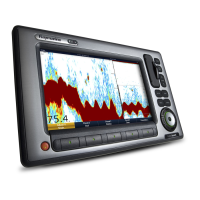88 E-Series Networked Display Reference Manual
4.12 Monitoring where you are going
... using chart vectors
You can display a variety of graphical indicators to help monitor where you are going.
The chart vectors can be set to either; Thin, Normal (default), or Wide:
Note:
Any vectors applied to a chart window that is set to system view, will be dis-
played in all other system view chart windows.
Heading (HDG) and course over ground (COG) vectors
The ship’s heading (HDG) is displayed as a line with an open arrow head. It does not
take account of winds or tides.
The course over ground (COG) indicates the boat’s actual course and is displayed as a
line with two open arrow heads.
The length of these lines is determined by the distance your boat will travel in the time
you have specified (3 mins, 6 mins or infinite) in the Chart Setup Menu (see
page 107
)
at the current speed.
Any times that you specify will apply to all chart views and if INFINITE is selected the
vector will extend to the edge of the chart window.
Note:
If neither the speed over ground (SOG) or heading are available, vectors cannot
be displayed.
Wind and tide arrows
Winds and tides are displayed as lines with solid arrow heads in the direction of the
wind or tidal set. Winds arrows point into your boat and tidal arrows point away. The
width of the arrow indicates its strength.
To switch graphical indicators on/off:
D6772-2
Heading vector
(HDG)
Course over ground
(COG)
D6773_2
Tide arrow
Wind arrow
81244_4.book Page 88 Thursday, January 31, 2008 1:53 PM

